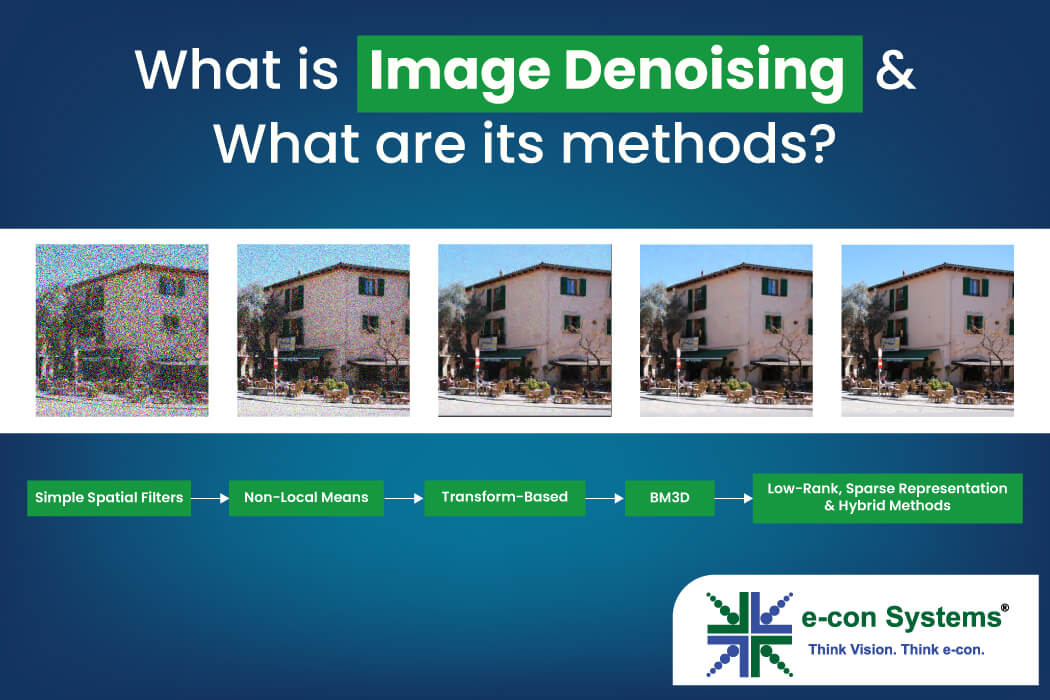Noise is an unwanted or random signal that interferes with and distorts the original audio, video, or image data. Likewise, in imaging, if an image contains visual noise, such as variation in brightness or color information due to sensor malfunction, challenging lighting conditions, or signal degradation over long-distance data transmission, the output image quality suffers from information loss. This data loss can obscure critical details, affect measurements, or even compromise downstream AI model performance.
Therefore, it’s important to remove noise from the image to preserve its details and ensure high quality. Thus, image denoising is a core step introduced in RAW image processing that helps preserve sharpness, color fidelity, and overall clarity.
This blog explores what image denoising is, delves into its various types, and provides a comprehensive overview of classic and contemporary denoising methodologies to produce clear, noise-free images for accurate downstream processing in AI-embedded applications.
Let us first understand the concept of image denoising and the sources from which it originates.
What is Image Denoising?
Image denoising refers to the computational process that eliminates noise—random pixel intensity fluctuations—from digital images. Noise can originate from various sources:
- Sensor limitations (e.g., low-light conditions, small pixel pitch)
- Analog-to-Digital Conversion process
- Transmission errors or environmental light conditions
Since the noise comes from different sources, it is important to identify common noise types to remove or reduce noise from the image.
Before learning about the denoising methods, let us see the most common noise types in the image.
Types of Noise in Images
- Gaussian Noise – Follows a normal distribution. The pixel value is altered by a random value drawn from a Gaussian distribution. It’s often caused by sensor electronics and is modeled as additive white Gaussian noise (AWGN).
- Salt-and-Pepper Noise – Appears as random black and white pixels, typically due to bit errors, faulty memory locations, or transmission faults.
- Poisson Noise – Poisson noise, also known as shot noise, arises from the random nature of photon detection in low-light environments. It depends on the signal and follows a Poisson distribution.
- Speckle Noise – Common in coherent imaging (e.g., medical ultrasound), characterized by multiplicative grain patterns.
Each noise type requires suitable denoising approaches for optimal results. Let us look into the evolution of denoising methods in cameras for the removal of image noise, encompassing both simple and complicated forms.
Evolution of Denoising Methods
Denoising methods have been introduced in the past decades, but they have gained improved performance with the evolution of advanced technology.
Let us see the evolution of denoising methods below.
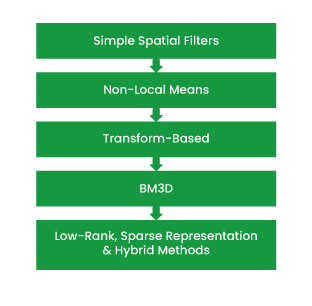
Figure 1: Evolution of Denoising Methods
In the section below, let’s focus on each denoising method to understand the specific scenarios where denoising methods, ranging from basic to advanced technologies, are applied in image processing.
-
Simple spatial filters
This simple filter methods manipulates the image directly by filtering pixels depending on the neighboring pixels. Some of the different types of spatial filters are listed below.
- Mean filter (averaging filter): Replaces each pixel with the average of its neighbors, smoothing both noise and details.
- Gaussian filter:Uses a weighted average based on spatial distance, better than the mean filter at preserving structure.
- Bilateral filter: Considers spatial distance and intensity similarity — good at edge preservation.
- Median filter (salt and pepper noise): A median filter removes salt and pepper noise by replacing each pixel’s value with the median of its neighboring pixels.
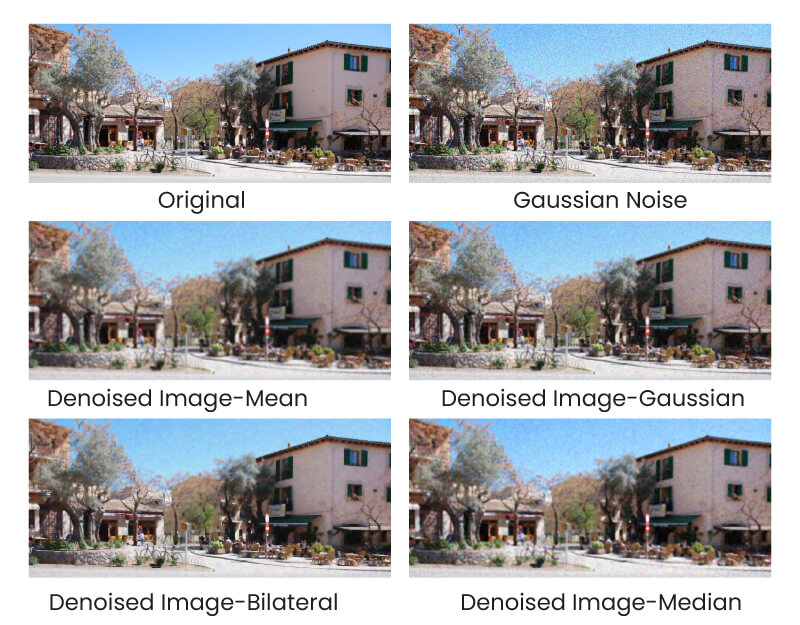 Figure 2: Simple Spatial Filters
Figure 2: Simple Spatial Filters
The median filter might not perform well with widespread Gaussian noise, but it is effective for salt and pepper noise.
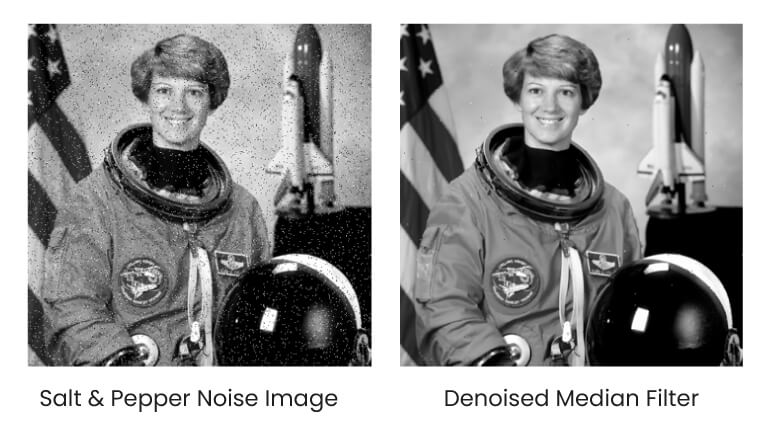
Figure 2: Salt and Pepper Noisy Image (Right) and Denoised Image with Median Filter
Spatial filters are local. They may blur edges and are less effective against noise distributed globally across the image.
-
Non-Local Means
Unlike local filters, the Non-Local Means filter method searches for similar patches across the full image/search window instead of the local area to better estimate the denoised pixel.
This works well for textures and fine structures and is better at preserving edges than Gaussian or Bilateral Filtering.
Even the Non-Local Means algorithm has limitations when processing large images, as its search for similar patches across the entire window can be time-consuming. Therefore, exploring alternative methodsspecifically designed for processing large images could lead to more efficient results.
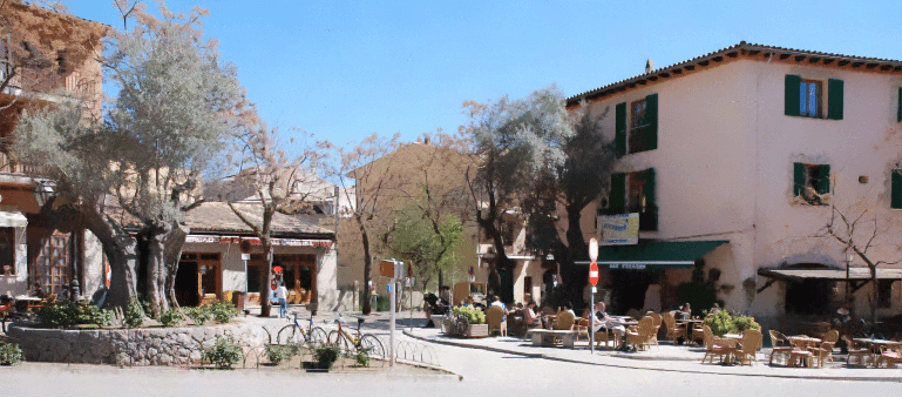 Figure 2: Denoised Image with Non-Local Means
Figure 2: Denoised Image with Non-Local Means
-
Transform-Based
The Transform-Based method converts the image into the frequency domain, where noise and important details are naturally separated instead of filtering pixels directly.
The two key transform methods are explained below
- Wavelet Transform Denoising
This approach divides the image into multiple frequency components into high, medium, and low frequencies, for further analysis or processing. High-frequency components mainly contain noise, while low-frequency components contain important image structures like edges and textures. To denoise the image, a threshold is applied to remove the high-frequency noise, thus preserving the image’s useful content.
- Discrete Cosine Transform (DCT)
The DCT is Similar to the Fourier Transform but specifically optimized for image compression and denoising. It works by representing the image as a sum of cosine waves. In image data, noise tends to concentrate on the high-frequency cosine coefficients, so these weaker coefficients can be removed to reduce noise.
 Wavelet denoising generally introduces fewer artifacts than DCT, thanks to its localized, multi-scale processing. While DCT is more computationally efficient, it is more prone to blocking artifacts, especially under strong noise reduction. Both methods can produce artifacts if denoising is too aggressive.
Wavelet denoising generally introduces fewer artifacts than DCT, thanks to its localized, multi-scale processing. While DCT is more computationally efficient, it is more prone to blocking artifacts, especially under strong noise reduction. Both methods can produce artifacts if denoising is too aggressive.
-
BM3D
The BM3D method is a short form of Block – matching and 3D filtering. This denoising method operates on the principle of finding similar patches across the image, much like the Non-Local Means algorithm. It stacks these similar 2D patches into a 3D block. A transform, such as the Wavelet Transform or Discrete Cosine Transform (DCT), is then applied to this entire 3D structure. Collaborative filtering is performed within this transform domain, employing denoising methods like thresholding or Wiener filtering to reduce noise. Finally, the processed patches are aggregated back into their original positions in the image, with overlapping regions typically averaged to produce the final denoised output.
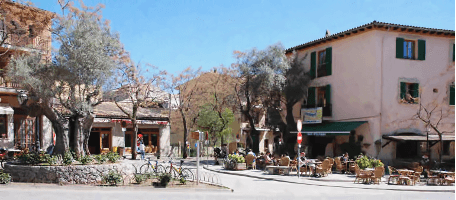 BM3D – Denoised Image
BM3D – Denoised Image
Although the BM3D denoising method works well for Gaussian noise, it struggles with structured noise.
Advantages of Using BM3D Technology
- Improved Denoising: It reduces noise more efficiently by denoising whole 3D groups of similar patches, not just individual ones.
- Information Preservation: It preserves fine details better by filtering in transform space rather than just using weighted averages.
-
Low-Rank Denoising, Sparse Representation-Based Denoising and Hybrid Methods
Low-rank, sparse, and hybrid models are among the advanced techniques used in image denoising. Each category includes a variety of denoising methods. In the following section, let us explore common methods from each type.
Low-Rank Denoising
This approach assumes that clean images exhibit strong internal structures and can be represented by low-rank matrices, while noise appears as sparse, high-rank outliers. Techniques like Robust Principal Component Analysis (RPCA), one of the low-rank denoising methods, separate structured image content from noise and work well for repetitive textures and background modeling. However, they can be computationally intensive.
Sparse Representation-Based Denoising
In this method, image patches are assumed to be sparsely represented over a learned dictionary. Noise, being incoherent with this basis, is easily separated. Methods like Weighted Nuclear Norm Minimization (WNNM), one of the sparse representation-based denoising methods, group similar patches and enforce low-rank constraints within them, offering strong detail preservation but requiring careful patch matching.
Hybrid Approaches
Modern denoising combines low-rank modeling, sparse coding, and transform-based filtering. Techniques like WNNM and deep plug-and-play priors integrate classical and learned components for more robust performance across diverse noise types. These methods offer high restoration quality but often require more computational resources and data-driven tuning.
e-con Systems: An Embedded Vision Pioneer
Since 2003, e-con Systems has been at the forefront of designing, developing, and manufacturing cutting-edge embedded vision cameras. With our camera domain expertise, we understand the critical role that image denoising plays in ensuring high-fidelity image output — especially in applications where lighting, motion, or environmental factors introduce significant noise.
Our camera solutions are built with optimized denoising algorithms, delivering superior image quality even under the most challenging conditions.
To explore our full range of cameras built with advanced imaging technologies, visit our Camera Selector Page.
For expert advice on choosing the right camera solution, reach out to us at camerasolutions@e-consystems.com.
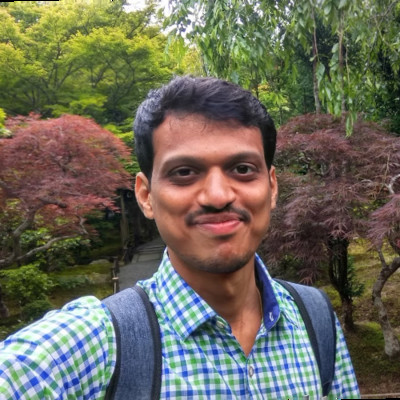
Prabu is the Chief Technology Officer and Head of Camera Products at e-con Systems, and comes with a rich experience of more than 15 years in the embedded vision space. He brings to the table a deep knowledge in USB cameras, embedded vision cameras, vision algorithms and FPGAs. He has built 50+ camera solutions spanning various domains such as medical, industrial, agriculture, retail, biometrics, and more. He also comes with expertise in device driver development and BSP development. Currently, Prabu’s focus is to build smart camera solutions that power new age AI based applications.




